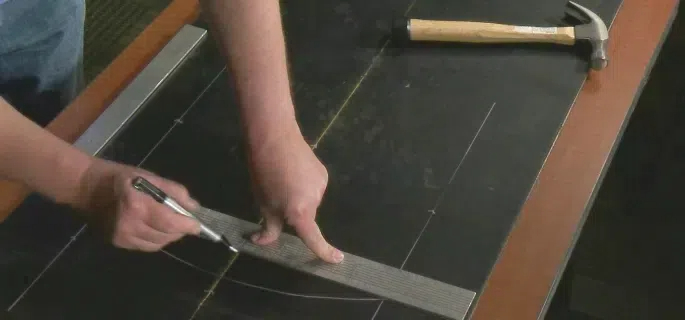How to Cut Conveyor Belt Straight: Tools, Methods, Precautions
In this comprehensive guide, we delve into the practical methods and crucial techniques on how to cut a conveyor belt straight, highlighting the significance of precision in this process. The integrity and functionality of a conveyor belt system heavily depend on the accuracy of the cuts made during installation, maintenance, or repair.How to cut conveyor belt straight is essential not only for the aesthetic alignment of the belt but also for its longevity and efficient performance. Incorrect or jagged cuts can lead to belt misalignment, rapid wear and tear, and ultimately, system failures, causing unnecessary downtime and financial losses. Throughout this post, we will explore various tools and techniques designed to achieve the perfect straight cut, ensuring your conveyor belt operates at its optimum capacity. Whether you’re a seasoned professional or a novice in the field of conveyor belt maintenance, this guide will equip you with the knowledge and skills needed to master the art of cutting a conveyor belt straight.
How to Cut Conveyor Belt Straight: Hand Cutting Techniques
Basics of Hand Cutting Conveyor Belts
When it comes to understanding how to cut conveyor belt straight, knowing the right tools for hand cutting is essential. The five primary tools you’ll need include utility knives for precise cuts, straight edges or rulers for guidance, chalk or markers for visible markings, measuring tapes for accurate length assessment, and cutting mats to protect the underlying surface. Each tool plays a pivotal role in ensuring a straight and clean cut, which is crucial for the belt’s performance and durability.
Safety cannot be overstated when performing hand cuts. Always wear cut-resistant gloves to protect your hands from sharp blades and potential slips. Safety goggles are a must to prevent any debris from harming your eyes. Ensure a well-ventilated area to avoid inhalation of any fine particles. Keep your work area organized to prevent accidents, and always use sharp blades to reduce the risk of the knife slipping and causing injuries.
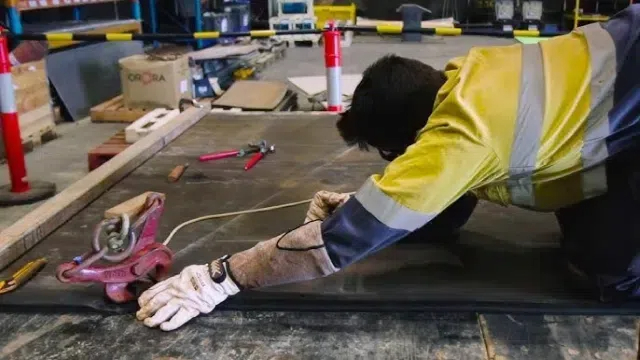
Step-by-Step Guide to Hand Cutting
The technique for how to cut conveyor belt straight begins with proper measuring and marking. First, use your measuring tape to determine the exact length needed, marking the start and end points with your chalk or marker. Align your straight edge or ruler along these marks to serve as a guide for your utility knife, ensuring it remains perfectly parallel to the belt’s edge for a straight cut.
Scoring and cutting the belt while keeping the blade straight involves a steady hand and focused attention. Position your utility knife against the ruler’s edge, applying even pressure as you score along the marked line. It may require several passes to cut through the thickness of the conveyor belt material. Keep the knife at a consistent angle to maintain a straight cut. Remember, patience and precision are key. A rushed job can lead to uneven edges, which can significantly affect the belt’s performance and longevity.
By mastering these hand cutting techniques and understanding how to cut conveyor belt straight, you ensure the operational efficiency and durability of your conveyor system, minimizing potential downtime and maximizing productivity.
How to Cut Conveyor Belt Straight: Power Tools
Preparing to Use Power Tools
Before diving into how to cut conveyor belt straight with power tools, it’s imperative to prioritize safety and proper tool preparation. Necessary safety gear includes heavy-duty gloves, eye protection, earplugs or earmuffs, and a dust mask or respirator. Preparing your tools involves ensuring they are in good working condition, the blades are sharp, and they are suitable for the material you intend to cut. The types of power tools that can effectively be used for this task include angle grinders, circular saws, oscillating tools, jigsaws, and reciprocating saws, each offering unique benefits for cutting different conveyor belt materials.
Cutting Conveyor Belt with Angle Grinder
Achieving a straight cut on a conveyor belt with an angle grinder requires precision and the right setup. Begin by selecting a suitable wheel type, such as a diamond-tipped blade for durability and efficiency. Secure the conveyor belt to a stable surface to prevent movement. Mark your cutting line clearly on the belt. When using the angle grinder, maintain a steady hand and align the blade with the cutting line, applying consistent pressure and speed to ensure a straight cut. Remember to make several gentle passes rather than one forceful cut, to achieve a clean edge.
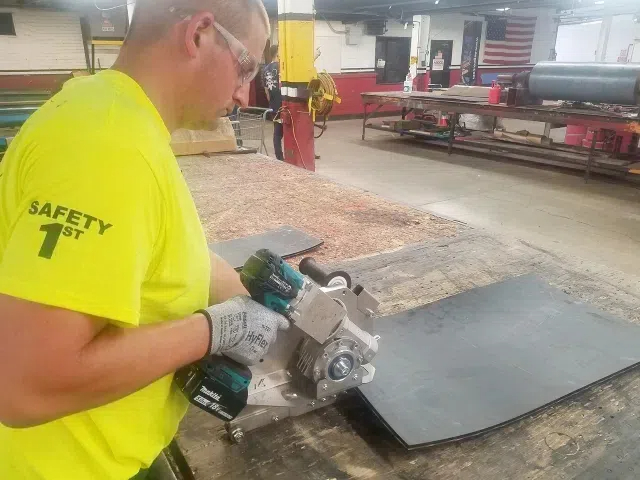
Cutting Steel Reinforced Conveyor Belts
Cutting steel reinforced conveyor belts presents unique challenges, including potential damage to tools and the belt itself. Challenges include managing the tough steel cables, preventing overheating, and avoiding uneven cuts. Using an angle grinder with a metal cutting disc can effectively slice through the steel cables. The key is to make slow, steady cuts to avoid overheating and to use a guide to ensure the cut remains straight. Cooling the blade and belt intermittently can also prevent damage from excessive heat.
Using a Circular Saw to Cut Conveyor Belts
When using a circular saw, selecting the correct blade is crucial for how to cut conveyor belt straight. Opt for carbide-tipped blades designed for cutting rubber or similar materials. Before cutting, ensure the saw’s base plate is adjusted for proper depth to minimize wear and tear. Secure the conveyor belt and use a straight edge guide to ensure accuracy. Slowly guide the saw along the marked line, allowing the saw to do the work without forcing it, to achieve a clean, straight cut.
Cutting Conveyor Belts with an Oscillating Tool
An oscillating tool offers precision for intricate cuts or when working in tight spaces. Choose blades designed for cutting the specific material of your conveyor belt. Mark your cut line clearly, and if possible, clamp a straight edge as a guide. The oscillating tool should be moved smoothly along the guide, applying consistent pressure to ensure a straight, clean cut. This method is particularly useful for finishing touches or adjustments where precision is paramount.
Throughout each step of using power tools to cut conveyor belts, remember the importance of maintaining a straight line for the integrity and performance of the belt. By following these guidelines and techniques, you can achieve professional-grade results in your conveyor belt maintenance and repair projects.

Conveyor Belt Cutting Tools for How to Cut Conveyor Belt Straight
Overview of Conveyor Belt Cutting Tools
In the quest for understanding how to cut conveyor belt straight, the selection of specialized cutting tools becomes paramount. Tools such as the Flexco belt cutter are designed with the specific challenges of conveyor belt materials in mind. These tools offer significant advantages over conventional cutting methods. Firstly, they provide precision, ensuring that cuts are perfectly straight, which is critical for the belt’s alignment and functionality. Secondly, they reduce waste by minimizing material fraying and deformation. Thirdly, they save time, offering a quicker, more efficient cutting process compared to manual methods. Additionally, specialized tools enhance safety, reducing the risk of accidents associated with improper tool use. Finally, they ensure consistency, delivering uniform cuts that are essential for the seamless operation of conveyor systems.
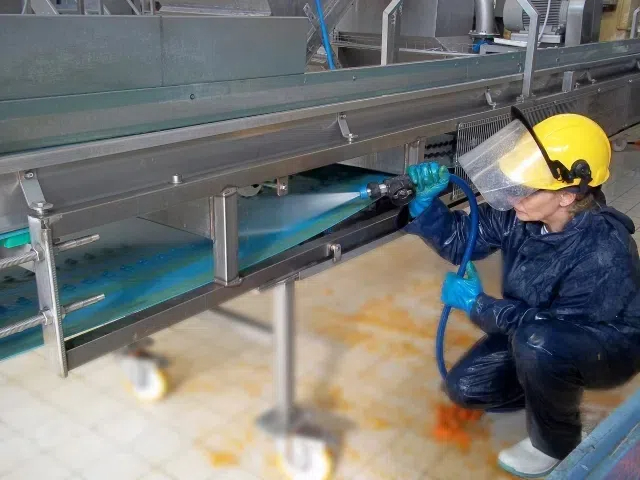
4 Common Tools for How to Cut a Conveyor Belt Straight
When it comes to cutting a conveyor belt straight, several tools are commonly used, each with its own advantages and ideal scenarios for application:
Utility Knife:
- Advantages: A utility knife, such as the Stanley Knife, is a commonly used manual tool for cutting conveyor belts. It’s simple, widely available, and inexpensive.
- Applicable Scenarios: This method is best suited for small, simple jobs where precision is less critical. However, it requires significant force to cut through tough materials, making it potentially unsafe for the user if not handled carefully.
Mechanical Belt Cutting Tool:
- Advantages: This tool uses a clamp-like mechanism to hold the belt securely in place while a blade is cranked through the material. It is much safer than a utility knife since the belt is firmly clamped, reducing the risk of accidents.
- Applicable Scenarios: Ideal for environments where safety is a priority, and precision cuts are required. However, it might not be suitable for cutting all types of belts or for use in tight spaces.
Electric Belt Cutter:
- Advantages: An electric belt cutter is a powerful, handheld device that can quickly and efficiently cut through conveyor belts with ease. It minimizes manual effort and provides a smooth, clean cut.
- Applicable Scenarios: This tool is ideal for larger-scale jobs or situations where efficiency is key. It’s especially useful in scenarios where frequent cutting is required. The downside is the cost of replacement blades and the potential for dulling, which can affect performance.
Slitting Machine:
- Advantages: A slitting machine is an industrial-grade tool that provides highly accurate cuts. It can handle large volumes of conveyor belts and is capable of cutting even narrow belts with precision.
- Applicable Scenarios: Best suited for companies that frequently cut conveyor belts or need to produce belts with precise dimensions. It is less practical for smaller operations due to its high cost and the space it requires.
Each tool offers unique benefits depending on the specific needs and scale of the cutting job.
Flexco Belt Cutter: A Key Tool for Straight Cuts
The Flexco belt cutter stands out as a premier tool for those needing to know how to cut conveyor belt straight, offering a combination of features and benefits tailored for this specific task. Its design allows for straight, clean cuts across various belt widths and thicknesses, which is essential for maintaining the integrity and alignment of the conveyor belt. The cutter is equipped with a durable, sharp blade that slices through rubber and other materials with minimal effort. Its ergonomic design ensures user safety and comfort during the cutting process. The Flexco cutter is also built for durability, able to withstand the rigors of heavy use in industrial environments.
Using the Flexco belt cutter involves a few straightforward steps to achieve a precise, straight cut. Begin by securing the conveyor belt on a flat surface to prevent it from moving. Measure and mark your desired cut line clearly on the belt. Position the Flexco belt cutter at the start of the marked line, ensuring it is aligned correctly for a straight cut. Press down on the cutter’s handle to pierce the belt’s surface and then slide the cutter along the marked line. The blade will slice through the material, leaving a clean, straight edge that is essential for optimal conveyor belt performance.
By utilizing the Flexco belt cutter, professionals and maintenance teams can significantly improve their workflow, achieving precise, straight cuts that enhance the operational efficiency and lifespan of conveyor belts.
Reasons to Cut Conveyor Belts
Cutting a conveyor belt is essential for addressing wear, correcting tracking errors, and ensuring proper fit. It also allows for material savings and efficient repairs.Here are five reasons why you might choose to cut your conveyor belt:
Belt Wear:
- Explanation: Over time, the friction between the conveyor belt and the transported materials or rollers can cause the belt to wear unevenly. This wear can lead to inefficient movement and even machine failures. Cutting away the worn sections and replacing them with new material can restore the belt’s efficiency and prolong its lifespan.
Belts Not Cut Properly, Causing Tracking Errors:
- Explanation: If a conveyor belt is not cut properly during manufacturing, even slight deviations can lead to tracking errors, where the belt does not move as intended along the conveyor. These errors can disrupt operations and lead to downtime while the issue is identified and corrected. Cutting and re-aligning the belt can solve these problems.
Belt Width Exceeds Requirements:
- Explanation: When a conveyor belt is wider than needed for the equipment, cutting it down to size ensures optimal performance. The excess material can often be reused for other purposes, reducing waste and improving overall efficiency.
Save Material:
- Explanation: Purchasing conveyor belts in larger dimensions can sometimes be more cost-effective due to bulk discounts. Cutting the belt to the exact size needed allows you to save the excess material for future use, maximizing your investment.
Repairing Damaged Sections:
- Explanation: Conveyor belts can sustain damage from sharp objects, excessive wear, or other mechanical issues. Cutting out the damaged section and splicing in a new piece can restore the belt to working condition without needing to replace the entire belt, saving both time and money.
These reasons highlight the practical benefits of cutting conveyor belts to maintain and optimize your equipment’s performance.
Safety Measures for How to Cut a Conveyor Belt Straight
It is never too much to pay attention to safety when cutting conveyor belts. Here are six safety measures for cutting a conveyor belt straight:
- Wear Appropriate PPE (Personal Protective Equipment): The person cutting the belt should wear thick gloves, aprons, and goggles to protect against serious injuries from sharp blades.
- Make Sure the Blades Are Sharp: Dull blades can slip and cause accidents. Always have a spare razor blade on hand and check the sharpness of the blade every few meters.
- Cut Away from the Body: Always angle the blade away from your body to ensure that if the blade slips, it won’t cause injury.
- Secure the Belt Firmly: Ensure the conveyor belt is securely clamped or held in place before cutting. This prevents the belt from moving during the cut, reducing the risk of accidents.
- Use Proper Cutting Tools: Utilize tools specifically designed for cutting conveyor belts, such as a mechanical belt cutter or an electric belt cutter. These tools are safer and more efficient than improvised methods.
- Maintain a Clear Work Area: Keep the cutting area clear of unnecessary tools, materials, and other obstructions. A clutter-free workspace minimizes the risk of tripping or accidental injury while cutting.
Proper Steps for How to Cut a Conveyor Belt Straight
Following the correct steps for cutting a conveyor belt is essential to ensure both the efficiency and safety of your operation. A properly cut belt minimizes the risk of tracking errors, which can lead to costly downtime and damage to the equipment. Additionally, precise cutting helps extend the lifespan of the belt by ensuring it fits correctly and operates smoothly. By adhering to the right procedures, you also reduce the risk of accidents, making the process safer for anyone involved. Proper cutting techniques are crucial for maintaining the overall performance and longevity of your conveyor system.
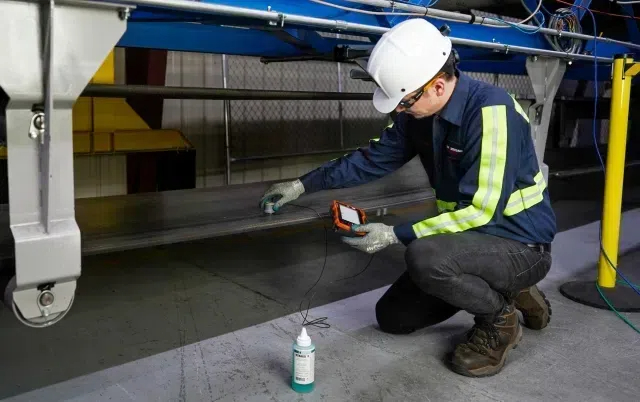
Measure and Mark the Belt:
- Begin by laying the conveyor belt on a flat, stable surface. Use a measuring tape or ruler to determine the exact length and width needed. To ensure a straight cut, use a straightedge or a chalk line to mark the cutting line across the belt. This line should be perfectly straight to avoid any jagged or curved edges, which can cause tracking errors during operation.
Secure the Belt Firmly:
- Before making any cuts, ensure the belt is securely clamped or held in place. Use a mechanical clamp or a similar tool to prevent the belt from shifting during the cutting process. This step is crucial for maintaining accuracy and safety, as a moving belt can lead to uneven cuts or potential injury.
Make Controlled, Small Cuts:
- With the belt securely in place and the cutting line marked, start making the cuts along the line using a sharp utility knife or a designated cutting tool. Instead of using large, powerful strokes, make small, controlled cuts. This approach allows for greater precision and reduces the risk of the blade slipping. Gradually deepen the cut until the belt is completely severed, maintaining a steady pace to ensure a straight edge.
Inspect and Finish the Cut:
- After the cut is complete, inspect the edge of the belt for any irregularities or rough spots. If needed, trim any uneven sections to ensure a clean, straight edge. Double-check the measurements and alignment of the cut belt to confirm it meets the required specifications. This final inspection ensures that the belt will perform optimally during operation, without any tracking or fitting issues.
Things to know beforehand for How to Cut a Conveyor Belt Straight
When cutting a conveyor belt straight, it’s important to consider the physical demands and environmental conditions before starting the process:
- Physical Strain: Cutting thick or long conveyor belts requires significant physical strength and can put a considerable strain on your hands and wrists. To prevent injury, take breaks as needed and ensure that you are using the correct tools to minimize the effort required. It may also be helpful to have an extra set of hands to assist with the task, especially for longer or heavier belts.
- Weather Conditions: Environmental factors such as wet or cold weather can affect the cutting process. Cold temperatures can make the belt harder and more difficult to cut, while wet conditions can make it slippery, increasing the risk of accidents. Ensure that you are working in a dry, stable environment and take extra precautions if the weather is not ideal.
Best Practices and Tips for How to Cut Conveyor Belt Straight
Ensuring Excellence in How to Cut Conveyor Belt Straight
Best Tool Selection for Different Conveyor Belt Materials
Choosing the right tool for cutting various types of conveyor belts is essential in how to cut conveyor belt straight. For rubber belts, a sharp utility knife or a specialized belt cutter like the Flexco can ensure a clean, straight cut. PVC belts may require the precision of an oscillating tool or a hot knife to seal the edges as it cuts, preventing fraying. Steel reinforced belts pose a significant challenge due to their toughness; here, an angle grinder or a circular saw equipped with a metal-cutting blade is ideal. Each material demands a tool that aligns with its properties, ensuring not only a straight cut but also minimizing damage and wear to both the belt and the tool.
Tips for Achieving a Perfect Straight Cut
Achieving a perfect straight cut on a conveyor belt requires adherence to a few expert tips. First, always start with accurate measurements and clear markings. Use a chalk line or a long straight edge to mark your cut line across the belt. Ensure the belt is flat and tension-free during marking to avoid any misalignment. When cutting, use guides like clamps and straight edges to maintain the tool’s path. Proceed slowly and steadily, allowing the tool to work through the material without force. If using power tools, ensure the blade is suited to the belt’s material and keep it sharp for a cleaner cut. These practices not only contribute to a straighter cut but also reduce the risk of accidents and tool damage.

Maintenance and Upkeep of Tools
Proper care and maintenance of your belt cutting tools are paramount to extend their lifespan and maintain their effectiveness. Clean your tools after each use to prevent the buildup of materials that can dull blades and cause malfunction. Regularly inspect blades for wear and replace them as needed to ensure clean, straight cuts. Lubricate moving parts to keep them operating smoothly. For power tools, check cords and batteries for damage and ensure they are in good working order. Storing tools in a dry, clean environment will prevent rust and corrosion. Adhering to these maintenance practices ensures your tools are always ready for the precise task of how to cut conveyor belt straight, safeguarding your investment and enhancing your operational efficiency.
Get expert advice on choosing the best conveyor belts.
FAQs About How to Cut Conveyor Belt Straight
The best way to cut a conveyor belt involves a combination of proper preparation, precise measurement, and the use of appropriate tools. Start by ensuring the belt is flat and tension-free on a stable surface. Measure the length you need to cut, using a tape measure, and mark the cut line with chalk or a marker for visibility. For a straight cut, align a straight edge or a ruler along the marked line to serve as a guide for your cutting tool. When it comes to the actual cutting, the method depends on the material of the conveyor belt. Rubber and PVC belts can be cut using a sharp utility knife or a specialized conveyor belt cutter, like the Flexco belt cutter, for precision and ease. Steel-reinforced belts may require the use of power tools such as angle grinders or circular saws with metal-cutting blades. Regardless of the tool, proceed with steady hands and make multiple gentle passes to achieve a clean, straight cut. Remember, safety is paramount, so wear appropriate protective gear, including gloves and eye protection.
The best tool to cut a conveyor belt depends largely on the belt’s material and the precision required for the cut. For standard rubber and PVC belts, a heavy-duty utility knife or a specialized conveyor belt cutter, such as the Flexco belt cutter, is ideal for achieving straight, clean cuts with minimal effort. These tools are designed specifically for cutting conveyor belts and offer a combination of sharpness, durability, and safety. For belts with steel reinforcements or for cutting through thicker materials, power tools like angle grinders, circular saws, or even a jigsaw with the appropriate blade are more suitable. These tools can handle the tougher materials but require a steady hand and experience to ensure a straight cut. Always consider the specific needs of your project, including the thickness and material of the belt, to select the best tool for the job.
Aligning a conveyor is critical for its efficient operation and longevity. Start by checking the conveyor’s framework and substructure for levelness and squareness. Adjust the legs or support structures as necessary to ensure the frame is level across its length and width. For the belt alignment, first, ensure the belt is tensioned correctly according to the manufacturer’s specifications. Misaligned rollers and pulleys are common causes of belt misalignment. Adjust these components so they are square with the frame and parallel to each other. Use a laser alignment tool or a long straight edge to check the alignment of rollers and pulleys. Additionally, inspect the belt edges for wear, which can indicate misalignment. Regularly inspect the conveyor while it’s running to observe the belt’s movement and make adjustments as needed. Proper alignment reduces wear and tear on the belt and the conveyor’s components, leading to longer service life and reduced maintenance costs.
Measuring and cutting a conveyor belt accurately is essential for the proper fitting and function of the belt. To measure the belt, first, determine the length needed for your specific application. Use a flexible measuring tape to measure the distance where the belt will be installed, considering any loops or additional length required for splicing or tension adjustments. Mark the measurement clearly on the belt using a chalk line or marker. For cutting, ensure the belt is laid out flat on a stable, non-slip surface. Use a straight edge or a long ruler to align with your marks, serving as a guide for a straight cut. For the cutting tool, select based on the belt’s material: a sharp utility knife or a specialized belt cutter for rubber and PVC belts, or power tools like an angle grinder or circular saw for reinforced or thicker belts. Always make a preliminary scoring cut before proceeding with deeper cuts to ensure accuracy and straightness. Safety gear, including gloves and eye protection, is a must during this process to protect against accidents.
To cut a conveyor belt straight, begin by measuring and marking the cutting line using a ruler or chalk line to ensure accuracy. Secure the belt firmly with clamps to prevent movement during the cutting process. Using a sharp cutting tool, such as a utility knife or mechanical belt cutter, make small, controlled cuts along the marked line. Avoid large, forceful strokes, as these can lead to jagged edges or errors. Gradually deepen the cut until the belt is fully severed. After completing the cut, inspect the edge for any irregularities and trim if necessary to achieve a clean, straight edge. Following these steps ensures that the belt will fit and function correctly, reducing the risk of tracking errors or equipment malfunctions. Proper cutting also extends the lifespan of the belt by preventing unnecessary wear and tear during operation.
Several tools can be used to cut a conveyor belt, depending on the belt’s material and thickness. A utility knife, such as a Stanley Knife, is a common choice for thinner rubber belts, though it requires significant force and careful handling to avoid accidents. For a safer and more precise cut, a mechanical belt cutting tool can be used, which clamps the belt securely and allows for controlled cutting with a handle-driven blade. Electric belt cutters offer an efficient, quick option for cutting thicker belts, though they may require frequent blade replacements. For industrial settings, a slitting machine is ideal, providing high accuracy for large-scale or frequent cutting tasks. Each tool offers specific benefits, so choosing the right one depends on the belt material, the precision required, and the frequency of cutting tasks.
Adjusting a conveyor belt to run straight involves several steps to correct any misalignment that may be causing tracking errors. First, inspect the belt and rollers for any signs of wear, damage, or debris that could affect alignment. Next, check the tension of the belt, ensuring it is evenly distributed across its width; uneven tension can cause the belt to drift to one side. Adjust the tension as needed by tightening or loosening the take-up bolts at each end of the conveyor. If the belt still doesn’t run straight, adjust the position of the rollers, starting with the head and tail pulleys. Make small, incremental adjustments, observing the belt’s movement after each change. Align the pulleys so that they are parallel to the conveyor frame. Regular maintenance and adjustments are key to keeping the belt running straight, ensuring efficient and trouble-free operation.
Cutting a conveyor belt straight by hand requires careful preparation and technique. Start by laying the belt on a flat, stable surface and measure the desired cut line with a ruler or straightedge. Mark the line with a chalk line or marker to ensure a clear guide for cutting. Secure the belt with clamps to prevent any movement during the cutting process. Using a sharp utility knife or heavy-duty shears, begin making small, controlled cuts along the marked line. Avoid large, forceful strokes, as they can lead to jagged edges or inaccuracies. Continue making measured cuts, gradually deepening the line until the belt is fully severed. It’s important to take your time and maintain a steady pace to achieve a clean, straight edge. After cutting, inspect the edge for any irregularities and make any necessary adjustments to ensure a precise, straight cut.
Cutting a conveyor belt straight with an angle grinder can be effective, particularly for thick or reinforced belts, but it requires precision and safety precautions. Begin by marking the desired cut line using a ruler and chalk line to ensure accuracy. Secure the belt firmly to prevent any movement during the cutting process. Equip the angle grinder with a suitable cutting disc, such as a diamond blade or metal-cutting disc, depending on the belt material. Hold the grinder at a slight angle to the belt and start cutting along the marked line, applying steady pressure. Move the grinder slowly and carefully, allowing the blade to do the work. Avoid forcing the blade, as this can cause it to bind or wander off course. After completing the cut, inspect the edge for any unevenness and trim if necessary. Always wear appropriate safety gear, including goggles and gloves, to protect against sparks and debris.
Cutting a steel-reinforced conveyor belt requires specialized tools and careful technique due to the strength and durability of the materials involved. Begin by marking the cutting line using a straightedge and chalk line for accuracy. Secure the belt firmly with clamps to prevent movement. For the initial cut through the rubber, use a utility knife or mechanical belt cutter. Once the rubber is cut, you’ll need to address the steel reinforcement. An angle grinder with a metal-cutting disc is typically the most effective tool for this. Carefully cut through the steel wires along the marked line, applying steady pressure to avoid damaging the surrounding rubber. It may be necessary to cut the steel in sections, depending on the thickness and type of reinforcement. After cutting, inspect the belt for any sharp edges or irregularities and smooth them out as needed. Always wear appropriate PPE, including gloves, goggles, and hearing protection, when working with steel-reinforced belts.
Last Updated on August 9, 2024 by Jordan Smith
Jordan Smith, a seasoned professional with over 20 years of experience in the conveyor system industry. Jordan’s expertise lies in providing comprehensive solutions for conveyor rollers, belts, and accessories, catering to a wide range of industrial needs. From initial design and configuration to installation and meticulous troubleshooting, Jordan is adept at handling all aspects of conveyor system management. Whether you’re looking to upgrade your production line with efficient conveyor belts, require custom conveyor rollers for specific operations, or need expert advice on selecting the right conveyor accessories for your facility, Jordan is your reliable consultant. For any inquiries or assistance with conveyor system optimization, Jordan is available to share his wealth of knowledge and experience. Feel free to reach out at any time for professional guidance on all matters related to conveyor rollers, belts, and accessories.

